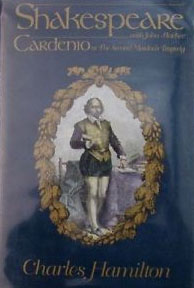THE MISSING FLETCHER
Because the 1653 entry in the Stationer’s Register assigns The History of Cardenio to both Fletcher and Shakespeare, Hamilton is forced to acknowledge Fletcher’s involvement in the play. But one rather gets the feeling that he’d rather not be bothered by it.
For example, the entire foundation of his argument rests on two principles: First, that he has identified the handwriting in the manuscript as belonging to Shakespeare. Second, that the script constitutes a rough draft in which the names of the characters had been replaced or removed (prior to the original names being restored).
But if the entire rough draft were written by Shakespeare, what happened to Fletcher’s contribution? Hamilton wants to assign the entirety of the sub-plot to Fletcher (the bit that was actually based on Don Quixote), but if Fletcher wrote it, why is it (according to Hamilton) in Shakespeare’s handwriting? If Shakespeare wrote half the play and Fletcher wrote the other half, then we would expect to find the original manuscript written in two different hands. (For example, the manuscript for Sir Thomas More shows how scenes written by multiple authors would be stitched together into a single, cohesive manuscript before, presumably, being copied out by a scribe.)
IN CONCLUSION
These constitute the major flaws in Hamilton’s argument. But Hamilton’s scholarship is also frequently incoherent in its specific details, as well. And many of these inconsistencies seem to be driven from his need to reach for the conclusion he desires.
 For example, when Hamilton feels a need to explain why The Second Maiden’s Tragedy would so drastically deviate from the “source material” of the Cardenio story he starts by trying to expose the “serious flaws of Cervantes as a writer” and, thus, discredit the quality of Cervantes’ original tale. To that end, he writes:
For example, when Hamilton feels a need to explain why The Second Maiden’s Tragedy would so drastically deviate from the “source material” of the Cardenio story he starts by trying to expose the “serious flaws of Cervantes as a writer” and, thus, discredit the quality of Cervantes’ original tale. To that end, he writes:
Now, when a distraught maid, armed with a bare bodkin in her bodice, confronts the villain of the piece, the laws of drama require that she use the bodkin, either to stab herself or the villain, or to have the weapon wrested from her in a suspenseful struggle. To permit her to faint is a cheap trick. It is the same shabby device used by otherwise reputable writers of the last century (Thomas Hardy, for example) who, in a concession to Victorian prudery, would “draw the curtain of charity” over any scene that promised to be delectably prurient. (pg. 192)
But just three pages later, this “shabby device” and “cheap trick” has becomes a tour de force on the part of Shakespeare:
The dramatists deftly solved the problem and at the same time astonished and horrified their audience. Cardenio, with naked sword pointed at his beloved’s bosom, rushes at her, but the murderous task is too much for him and he falls in a dead faint at Luscinda’s feet. (pg. 195)
I suspect that a large part of Hamilton’s over-zealousness is born in his hero-worship of Shakespeare. In his Preface to the Play, for example, Hamilton writes:
I urge you to read at least scenes two, three, and four of Act IV, in which the necrophilic Tyrant steals the body of The Lady and the theft is disclosed to her lover, Govianus. Judge for yourself whether the chilling beauty of these nocturnal scenes in the cathedral does not evoke the magic touch of the Wizard of Stratford.
Hamilton’s love for the “Wizard of Stratford” is clear. But this is not scholarship. This is blind faith coupled to undying adulation.
Originally posted August 2010.












